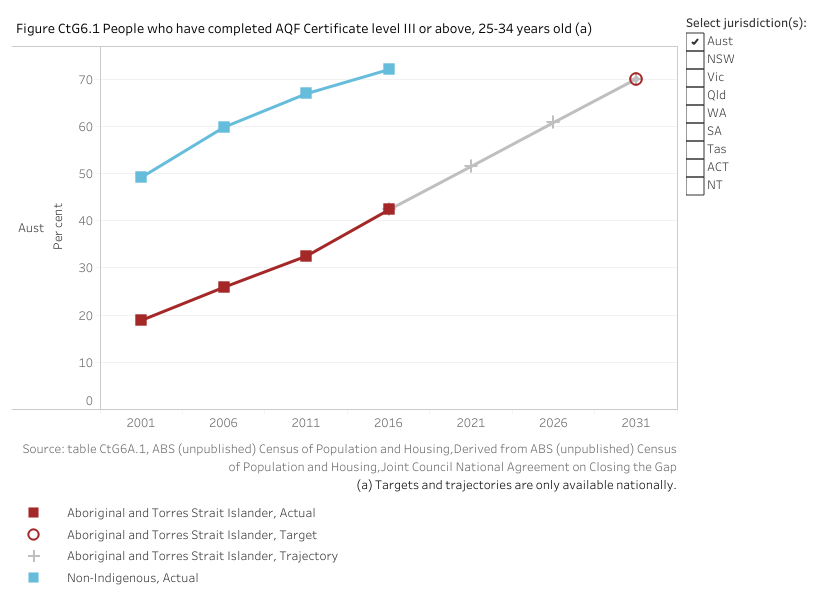TARGET 6
By 2031, increase the proportion of Aboriginal and Torres Strait Islander people aged 25-34 years who have completed a tertiary qualification (Certificate III and above) to 70 per cent
Dashboard snapshot: The data below are the most recent at the time of preparing the July 2021 report. Please go to the dashboard to access the current data.
Nationally in 2016, 42.3 per cent of Aboriginal and Torres Strait Islander people aged 25–34 years had completed non-school qualifications of Certificate III or above (figure CtG6.1).
There are no new data since the baseline year of 2016.

Target data specifications
Outcome: | Aboriginal and Torres Strait Islander students reach their full potential through further education pathways. |
|---|---|
Target: | By 2031, increase the proportion of Aboriginal and Torres Strait Islander people aged 25-34 years who have completed a tertiary qualification (Certificate level III and above) to 70 per cent. |
Indicator: | The proportion of Aboriginal and Torres Strait Islander people aged 25-34 years old who have completed qualifications at Certificate level III or above. |
Measure: | The measure is defined as: Numerator — number of Aboriginal and Torres Strait Islander people aged 25-34 years old who have completed non-school qualifications at Certificate level III or above based on the Australian Qualifications Framework (AQF). Denominator — total number of Aboriginal and Torres Strait Islander people in the population aged 25-34 years old. and is presented as a percentage. |
Target established: | National Agreement on Closing the Gap July 2020 |
Latest dashboard update: | 23 June 2021 |
Indicator type: | Target |
Interpretation of change: | A high or increasing proportion is desirable. An increase from the previous year or the baseline year is an improvement. |
Data source: | Name: ABS Census of Population and Housing Frequency: Five-yearly Documentation (links): www.abs.gov.au/census |
Data provider: | Provider name: Australian Bureau of Statistics Provider area: Census |
Baseline year: | 2016 |
Target year: | 2031 |
Disaggregations: | State and territory and Australia, by Indigenous status |
Computation: | Numerator divided by Denominator multiplied by 100 Counting rules Data are for all Australian residents enumerated in the Census that reported having a usual residence in Australia. Geographical variables are based on a person's place of usual residence. Includes (numerator)
Includes (numerator and denominator)
Excludes (numerator)
Excludes (both numerator and denominator)
Extraction Census Table Builder (Basic) – Employment, Income and Education: INGP X AGEP X HEAP (QALLP X HSCP prior to 2016) X Main ASGS (UR) |
Data quality considerations: | Data values have been randomly adjusted using perturbation to avoid the release of confidential data. |
Future reporting: | Additional disaggregations required for future reporting:
|
Supporting indicators
Driver
- Higher education commencement, attrition, and completion rates
University component | Time series, cohort analyses - 4, 6 and 9 years - Higher education application, offers and acceptance rates
By gender, SES and ATAR levels - Cert III and above VET commencements, attrition and completion rates
Contextual information
- Field of Education for higher education and VET
- Higher education students’ views on outcomes, behaviours and satisfaction
- Destinations and satisfaction of higher education graduates
- VET graduate outcomes and satisfaction levels
- Progress towards parity
